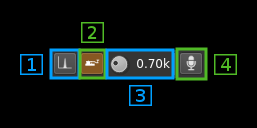<h1>AM modulator plugin</h1> <h2>Introduction</h2> This plugin can be used to generate a narrowband amplitude modulated signal. "Narrowband" means that the bandwidth can vary from 1 to 40 kHz. <h2>Interface</h2>  <h3>1: Frequency shift from center frequency of reception direction</h3> The "+/-" button on the left side of the dial toggles between positive and negative shift. <h3>2: Frequency shift from center frequency of reception value</h3> Use the wheels to adjust the frequency shift in Hz from the center frequency of reception. Left click on a digit sets the cursor position at this digit. Right click on a digit sets all digits on the right to zero. This effectively floors value at the digit position. <h3>3: Channel power</h3> Average total power in dB relative to a +/- 1.0 amplitude signal generated in the pass band. <h3>4: Channel mute</h3> Use this button to toggle mute for this channel. <h3>5: RF bandwidth</h3> This is the bandwidth in kHz of the channel signal filtered after modulation. It can be set continuously in 1 kHz steps from 1 to 40 kHz. <h3>6: Modulation level</h3> Adjusts the AM modulation level in % <h3>7: Volume</h3> This is the volume of the audio signal from 0.0 (mute) to 2.0 (maximum). It can be varied continuously in 0.1 steps using the dial button. <h3>8: Level meter in %</h3> - top bar (beige): average value - bottom bar (brown): instantaneous peak value - tip vertical bar (bright red): peak hold value You should aim at keepimg the peak value below 100% using the volume control <h3>9: Input source control</h3>  <h4>9.1: Tone input select</h4> Switches to the tone input. You must switch it off to make other inputs available. <h4>9.2: Morse keyer input select</h4> Switches to the Morse keyer input. You must switch it off to make other inputs available. <h4>9.3: Tone frequency (kHz)</h4> Adjusts the tone frequency from 0.1 to 2.5 kHz in 0.01 kHz steps <h4>9.4: Audio input select</h4> Switches to the audio input. You must switch it off to make other inputs available. <h3>10: CW (Morse) text</h3> Enter the text to be keyed when Morse input is active and in text mode <h3>11: Clear CW text</h3> Clears the CW (Morse) text <h3>12: Morse keyer controls</h3>  <h4>12.1: CW keying speed</h4> Sets the CW speed in Words Per Minute (WPM). This is based on the word "PARIS" sent 5 times. For 5 WPM the dot length is 240 ms. In other terms the dot length is calculated as 1.2 / WPM seconds. The dot length is used as the base to compute other timings: - Element (dot or dash) silence separator: 1 dot length - Dash: 3 dot lengths - Character silence separator: 3 dot lengths - Word silence separator: 7 dot lengths <h4>12.2: Dots keying</h4> Switch this button to send dots continuously <h4>12.3: Dashes keying</h4> Switch this button to send dashes continuously <h4>12.4: Text keying</h4> Switch this button to send the text typed into the text box (10) <h4>12.5: Text auto repeat</h4> Switch this button to auto repeat the text keying <h4>12.6: Text play/stop</h4> Use this button to stop sending text. When resuming keying restarts at the start of text <h3>13: Audio file path</h3> The path to the selected audio file to be played or dots if unselected <h3>14: Audio file play controls</h3>  <h4>14.1: Audio file select</h4> Opens a file dialog to select the audio file to be played. It must be mono 48 kHz 16LE raw format. <h4>14.2: Audio file loop</h4> Audio replay file at the end <h4>14.3: Play/pause file play</h4> Toggle play/pause file play. When paused the slider below (17) can be used to randomly set the position in the file when re-starting. <h3>15: Play file current position</h3> This is the current audio file play position in time units relative to the start <h3>16: Play file length</h3> This is the audio file play length in time units <h3>17: Play file position slider</h3> This slider can be used to randomly set the currennt position in the file when file play is in pause state (button 14.3)